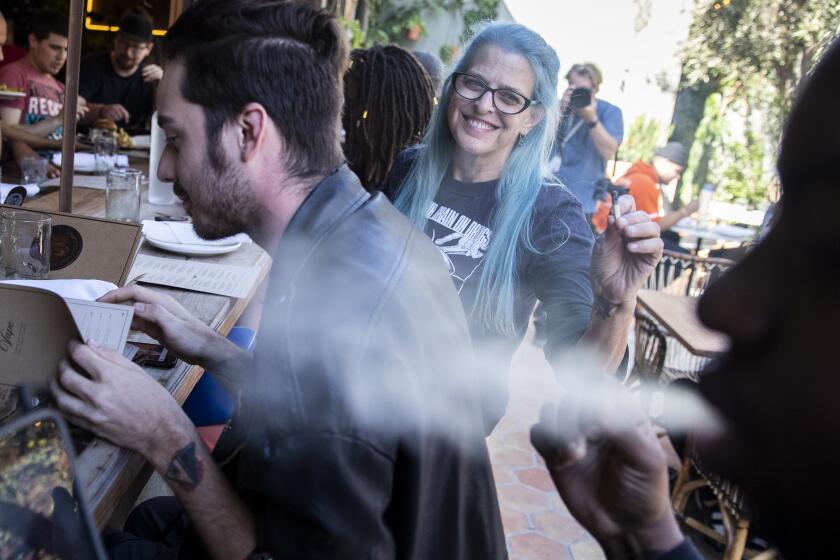Roots of pot cultivation in national forests are hard to trace

WELDON, Calif. — A few minutes after 4 a.m., agents in camouflage cluster in a dusty field in Kern County. “Movement needs to be slow, deliberate and quiet,” the team leader whispers. “Lock and load now.”
They check their ammunition and assault rifles, not exactly sure whom they might meet in the dark: heavily armed Mexican drug traffickers, or just poorly paid fieldworkers camping miserably in the brush.
Twenty minutes later, after a lights-off drive for a mile, the agents climb out of two pickup trucks and sift into the high desert brush.
PHOTOS: Raiding a marijuana grow
The granite faces of the Southern Sierra are washed in the light of a full moon. Two spotters with night-vision scopes take positions on the ridge to monitor the marijuana grow, tucked deep in a cleft of the canyon.
The rest of the agents hunker down in some sumac waiting for the call to move in. The action has to be precisely timed with raids in Bakersfield, where they hope to capture the leaders of the organization.
They have no idea how many people are up here. Thermal imaging aircraft circling high above was not detecting anyone on the ground. And trail cameras hadn’t captured images of men delivering supplies for more than a week. Maybe the growers have already harvested and cleared out.
Word comes on the radio to go into the site.
The agents fan out in the gray of dawn. A U.S. Forest Service agent unleashes a German shepherd and follows it up a piney slope. After several minutes, the dog begins barking furiously.
“We have movement,” shouts the Forest Service officer. “Hands up.”
::
Such raids have become commonplace in California, part of a costly, frustrating campaign to eradicate ever-bigger, more destructive marijuana farms and dismantle the shadowy groups that are creating them.
Pot cultivated on public lands surged in the last decade, a side effect of the medical cannabis boom. In 2001, several hundred thousand plants were seized in the state. By 2010, authorities pulled up a record 7.4 million plants, mostly on public land.
Law enforcement long called these grows on public land “cartel grows,” and hoped to work from the busts in the forest up the drug hierarchy, maybe all the way to the Sinaloa Cartel or the Zetas.
But after years of raids and work with informants and wiretaps, agents realize the operations seemed to be run by independent groups of Mexican nationals, often using undocumented fieldworkers from their home regions.
Tommy Lanier, director of the National Marijuana Initiative, part of the Office of National Drug Control Policy, said there was scant evidence that the cartels exerted much control over marijuana growing in the national forests.
“Based on our intelligence, which includes thousands of cellphone numbers and wiretaps, we haven’t been able to connect anyone to a major cartel,” he said.
Lanier said authorities have long mislabeled marijuana grown on public land as “cartel grows” because Mexican nationals are arrested in the majority of cases, and the narrative of fighting drug cartels helps them secure federal funding.
He doesn’t rule out that some of the cash flowing south of the border makes its way to members of those groups. He just doesn’t believe they are actively directing activities up here.
“We’ve had undercover agents at the highest level of these groups, breaking bread and drinking tequila,” says Roy Giorgi, commander of the Mountain and Valley Marijuana Investigation Team, a multi-agency organization headquartered in Sacramento. “Even at their most comfortable, the leaders never said, ‘Hey, we’re working for the Zetas.’ ”
In Giorgi’s jurisdiction, the majority of the people arrested or investigated are originally from the state of Michoacan, where marijuana growing and immigration to the U.S. are entrenched.
In their hometowns, growers have to sell their marijuana to cartels for a fraction of what they could make in California. When they come north, they see opportunity in the state’s vast wilderness. They have the know-how and perseverance to set up clandestine farms and live for months at a time in extremely rugged spots. Loncheros — lunchmen — often make weekly supply runs in the middle of the night, bringing food, beer and fertilizer. The workers wear camouflage, often sleep in the brush-covered tents, cook on propane stoves in crude kitchens and supplement their food by poaching deer and other wildlife.
Giorgi says these organizations can still be well-financed, heavily armed and dangerous.
Mendocino County Sheriff Tom Allman realized at a community meeting in 2010 how bad the situation was in the Mendocino National Forest when five of the eight people who went to the microphone said basically: “I was out in the national forest … herding cows or sheep or hiking or fishing. And someone shot at me. So I’m not going into the national forest.”
The following summer, Allman helped lead a task force on a three-week purge of pot from the area. They pulled out 632,000 plants, 42 miles of irrigation line and 52 tons of garbage. Agents arrested 132 people and confiscated 38 guns.
Is the forest safe today? “I’ll put it this way,” Allman said. “I’d go camping in the National Forest, but I wouldn’t let my sister go.”
Would he camp unarmed? “No.”
A Mexican-born grower working just outside Mendocino National Forest said the cartels may not run the grows, but the criminal ties to Mexico are vastly complex and dangerous. He hears stories all the time of drug gang shakedowns, and workers held captive in the forest, with threats to their families back home.
“There was a guy working right here,” he said, pointing over the hill from his grow, “he thought he was working in Texas.”
The grower operates in the quasi-legal medical marijuana world and has contacts on the public land grows. He asked to remain anonymous because he feared for his safety.
He said he thinks law enforcement has little grasp of what’s going on because no one arrested will put their family at risk to speak with them, even for a lighter sentence.
Lanier said agents are making progress. This season, they have seized about 3 million plants, less than half the number of last year. But with such a shadowy enemy, success is hard to gauge.
It’s not clear if the numbers mean fewer plants are being grown on public land, or just fewer are being found. Since the state Campaign Against Marijuana Planting was disbanded last year, agents spend less time on aerial surveillance. And local sheriffs in pot-growing counties like Mendocino and Humboldt have far less resources devoted to seeking out and eradicating plants than they had in the past.
“It’s hard to know if there’s less being grown if you’re not looking,” said Humboldt County Sheriff Lt. Steve Knight.
::
The investigation into the Kern County grow, just south of the Sequoia National Forest, began when a game warden spotted spilled fertilizer at a road turnout that had been a drop-off spot for marijuana growers four years before.
The warden set up surveillance and saw a Jeep Cherokee dropping off supplies several times. Two wardens pulled over the driver, Francisco Barrazarivas, for speeding one night in July. While one officer conducted a field sobriety test, the other placed a GPS device on his car, according to an affidavit filed with the search warrant.
Barrazarivas drove to a house in Bakersfield and was seen transferring two dark bags to a sedan, which was unloaded five houses up the block.
That second house was associated with a man named Ignacio Gomez, an illegal immigrant from Michoacan suspected to be the leader of a group that grows marijuana on public lands in Kern and Tulare counties, according to a Forest Service report included in the affidavit.
The raids come in the early morning Aug. 3.
In all, two aircraft, 43 agents, seven scientists and land managers, and eight volunteers would take part in the joint operation — at a cost of $35,000 to $40,000.
Two young men in camouflage are pulled out of a brush-covered tent. A Glock pistol is found in one of their sleeping bags, but neither man tried to grab it. They are the fieldworkers.
Game wardens trudge down the canyon with their guns drawn. They pass another tent and kitchen area overflowing with trash. Strung up on sticks is some type of salted game meats.
About 50 yards down in the canyon, they find 450 brilliant green marijuana plants all but glowing amid the dry summer brush. Many more stalks have already been harvested.
The scene is an ecological mess. Cottonwood trees and willows have been cut down to let in sunlight. Bags of fertilizer and trays of rat poison are strewn about. A dead hawk lies on one footpath. A coyote carcass is rotting up the hill.
A volunteer clean-up crew starts pulling up the hoses and rubbish. A helicopter comes with a net to lift the marijuana out. It takes two more flights to get the trash out.
Word comes on the radio that no one at the Bakersfield houses was arrested in relation to the grows. Gomez and Barrazarivas were gone.
The two men arrested in the woods are Cruz Soria, 27, of Bakersfield, and Mairo Correa-Garcia, an 18-year-old illegal immigrant from Michoacan.
Correa-Garcia’s lawyer, Dale Blickenstaff, said later that the young man told him he had been in the United States for a year and was working in Washington state, then came to Bakersfield when he heard there were better opportunities.
He was recruited to work for $100 a day — great pay for farm labor — and had been up on the grow site for a month.
Soria is now awaiting trial. Correa-Garcia pleaded guilty and was sentenced to five years in federal prison.
Neither one told investigators whom they were working for. They said they didn’t know.
More to Read
Sign up for Essential California
The most important California stories and recommendations in your inbox every morning.
You may occasionally receive promotional content from the Los Angeles Times.











